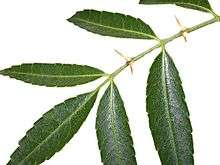Zanthoxylum coco
Zanthoxylum coco (also known as Fagara coco) is an evergreen tree of the family Rutaceae, native to Argentina and Bolivia where it grows in the wild, mostly hilly, spiniferous forests. Its natural habitat ranges the hilly forest of Sierras Pampeanas.
| Zanthoxylum coco | |
|---|---|
 | |
| Scientific classification | |
| Kingdom: | Plantae |
| Clade: | Tracheophytes |
| Clade: | Angiosperms |
| Clade: | Eudicots |
| Clade: | Rosids |
| Order: | Sapindales |
| Family: | Rutaceae |
| Genus: | Zanthoxylum |
| Species: | Z. coco |
| Binomial name | |
| Zanthoxylum coco Gillies ex Hook. & Arn. | |
| Synonyms | |
|
Fagara coco (Gillies ex Hook. & Arn.) Engl. | |
Description
The coco, also cochucho or smelly sauco, is usually found either in isolated groups or standing alone, from a small to medium-sized tree, ranging 6 to 8 metres in height . The foliage is abundant, evergreen with imparipinnate leaves that present paired spines presumably in the place of leaflets. Punctations, in pairs, on the leaflets are quite distinctive. Leaves have serrated margins and pinnate venation. Flowers have five petals and are arranged in panicular inflorescences. The fruit is spherically shaped, dehiscent; containing a shiny blackish seed.[1] The whole plant has a characteristic unpleasant smell, hence the alternative name "smelly sauco".[2]
Biochemistry
Even though unused in general botanical pharmacopeia, Zanthoxylum coco tissues are very rich in alkaloids. Fagarine, N-methylisocoridine, eskimminianine, α-fagarine, fagarine-2, magnoflorinne, nitidine, cheleritrinne, berberine, palmatine and candicine have been isolated from foliage and wood.[3]
Taxon synonym usage
The coco belongs to the genus Zanthoxylum. However, most local scientific articles use Fagara as the genus name.
References
- Stucker, G.V.: (1930), Contribución al estudio del Fagara coco, Congreso Internacional de Biología, Montevideo, Oct. 1930.
- Fernández Rua, R.: (1933), El alcaloide de la corteza del Fagara coco: la fagaridina, Córdoba, folleto - 12 pp. y tablas.
- Boelcke, O.: (1989) Plantas vasculares de la Argentina - Bs.As., Ed. H. Sur, 2da. reimpresión, 171 - 369 pp.
- Hieronymus, G.: (1882), Plantae Diaphoricae Florae Argentinae - Bs. A.s, Ed. Kraft, 53 - 404 pp.
- Domínguez, J. A.: (1928), Contribuciones a la Materia Médica Argentina, Bs. As., Ed. Peuser, 95 - 433 pp.
- Stucker, G.V.: (1930), Contribución al estudio del Fagara coco, Congreso Internacional de Biología, Montevideo, Oct. 1930.
- Fernández Rua, R.: (1933), El alcaloide de la corteza del Fagara coco: la fagaridina, Córdoba, folleto - 12 pp. y tablas.
- Boelcke, O.: (1989) Plantas vasculares de la Argentina - Bs.As., Ed. H. Sur, 2da. reimpresión, 171 - 369 pp.